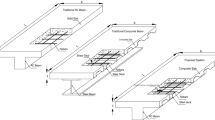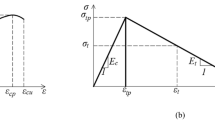Abstract
While modern prestressed techniques have improved the torsion properties of high-strength concrete (HSC) composite beams with prestressed steel (PS) boxes, no research has been reported in either the national or international literature on the anti-torque and composite torque properties of this type of beam. With the aim of understanding the torque properties of these beams, this paper presents results of ten comprehensive tests; three of these were based on stirrup spacings and prestressing levels as the main parameters, while the other seven were based on torsional rates. The torsion tests were conducted on the results which established several key parameters, including curves of constant torsion, strain curves of steel torsion, strain distribution of steel beams and concrete, curves of bending-moment and mid-span deflection, as well as cross strain distribution. The prestressing impact-factor method was adopted to deduce semiempirical equations for cracking torque in such composite beams. Furthermore, this involves the use of the equation of ultimate torque based on truss-model-theory of the distortion angle, the calculated results show good agreement with the measured values. In summary, this paper offers theoretical analysis for future applications of HSC composite beams with PS boxes, and provides both validation of the methods employed and a reference point for on-going research on composite beams and related anti-torque studies.
Similar content being viewed by others
References
Aziz S, Walid A. Full-scale test of continuity diaphragms in skewed concrete bridge girders. J Bridge Eng, 2010, 16(1): 21–28
Heidarpour A, Bradford M A. Improved flexural-torsional stability analysis of thin-walled composite beam and exact stiffness matrix. Int J Mech Sci, 2007, 49(8): 950–969
Chen L. Prestressed steel-HSC composite box beams under pure torsion & combined bending and torsion(in Chinese). Dissertation for Master Degree. Nanjing: Nanjing Hydraulic Research Institute, 2009
Hu S W, Nie J G, Zhu L S, et al. Complete history analysis on torsional performance of composite steel-concrete beams (in Chinese). Chinese J Comput Mech, 2004, 21(4): 435–454
Hu S W. Torsional Analysis and Design of Composite Steel-Concrete Beams (in Chinese). Beijing: China Communications Press, 2005. 66
Hu S W, Nie J G. Experimental study on composite steel-concrete beams with box sections under combined bending and torsion.Build Struct, 2006, 36(8): 54–59
Hu S W, Nie J G, Zhu L S. Nonlinear analysis of composite steel-concrete beams under combined flexure and torsion (in Chinese). Eng Mech, 2005, 22(2): 1–5
Dezi L. Shrinkage effects in composite beams with flexible connection. J Constr Steel Res, 2006, 3(28): 295–320
Lorenc W, Kubica E. Behavior of composite beams prestressed with external tendons: experimental study. Constr Steel Res, 2006, 6(62): 1353–1368
Nie J G, Tang L, Hu S H. Torsional strength of steel-concrete composite box griders (in Chinese). China Civil Eng J, 2008, 41(1): 1–10
Ranzi G, Bradford M A. Analytical solutions for the time-dependent behavior of composite beams with partial interaction. Int Solids Struct, 2006, 43(1): 3770–3793
Ray M B, Mallick S K. Interaction of flexure and torsion in steel-concrete composite beams. India Conc J, 1980, 54(3): 85–94
Chen S M, Gu P. Load carrying capacity of composite beams prestressed with ex-ternal tendons under positive moment. J Constr Steel Res, 2005, 61: 515–530
Slutter R G, Driscoll G C. Flexural strength of steel-concrete composite beams. J Struct Div, ASCE, 1965, 91 (ST2): 71–99
Singh R K, Mallick S K. Experiments on steel-concrete beams subjected to torsion and combined flexure and torsion. India Conc J, 1977, 51(1): 24–30
Xue W C, Ding M, He C. Long-term behavior of prestressed composite beams at service loads for one year. J Struct Eng-ASCE, 1980, 134 (6): 930–937
Nie J G, Zhou T R, Qin K, et al. Study on bending capacity of prestressed steel-concrete composite beams (in Chinese). Indus Constr, 2003, 33(12): 1–5
Hu S W, Nie J G, Luo L. Study on the torsional behaviors of steel-concrete composite beams. Build Struct, 1999, (4): 38–41
Author information
Authors and Affiliations
Corresponding author
Rights and permissions
About this article
Cite this article
Hu, S., Chen, L. Test analysis on prestressed concrete composite beams with steel boxes subjected to torsion and combined flexure and torsion. Sci. China Technol. Sci. 55, 3302–3310 (2012). https://doi.org/10.1007/s11431-012-5030-3
Received:
Accepted:
Published:
Issue Date:
DOI: https://doi.org/10.1007/s11431-012-5030-3




